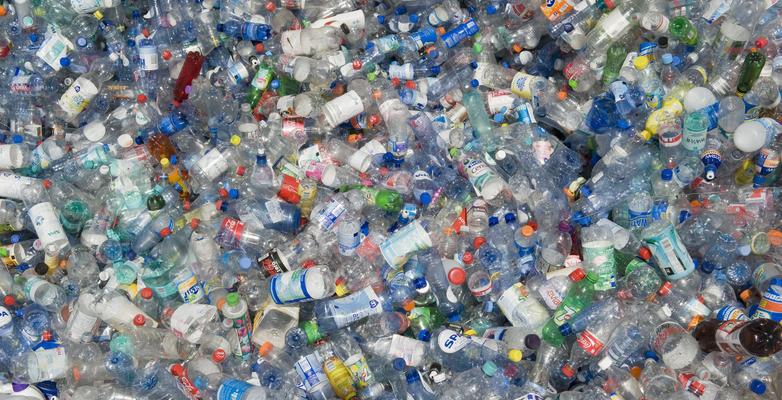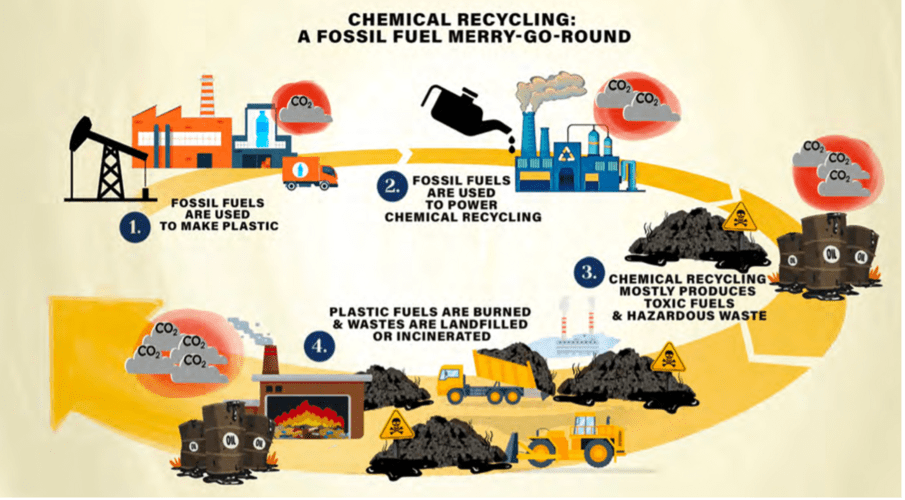
What is Chemical Recycling?
Communities all over the country are stepping up to share the real risks of petrochemicals, including advanced/chemical “recycling” facilities.
3 min read
“Advanced” or “chemical” recycling are umbrella terms developed by the petrochemical industry to describe processes that convert plastic waste to fuel or to chemical components that can be used in the creation of new plastics.
The American Chemistry Council defines this process as:
“Different processes to extract value from post-use plastics by converting them into their original building blocks, specialty chemicals, feedstocks for new chemicals and plastics, and other valuable products.”
The plastics and petrochemical industries tout these methods as a green solution to the enormous plastic waste crisis felt globally. Brands like America’s Plastic Makers claim advanced recycling is a viable technique to achieve sustainability and circularity in plastics, where they are “remade into new plastics and can be remade again and again.”
In reality, advanced recycling is mainly used to produce fuel, not additional plastics. The process uses an immense amount of energy and creates large amounts of toxic waste, which is often worse for the environment than manufacturing the original plastic, debunking industry claims of advanced recycling being a route to achieve sustainability in plastics.
These are old technologies greenwashed to appear eco-friendly
Pyrolysis has been around for centuries. It was used in the 1600s to make tar from timber, and in the 20th century to make coke from coal. Although more recently applied specifically to plastic, using this technology to burn waste (including plastic waste) has been explored since the 1950s.
This technology has struggled to be implemented at scale for decades. BP attempted waste-to-fuel pyrolysis over 20 years ago without commercial or technical success.
As of November 16, 2023, there were 11 constructed plants in the US. If all 11 of these plants operated at full capacity, which is not the case, they would process less than 1.3% of plastic waste generated annually in the US.
Advanced recycling plants have been repeatedly proven to be not financially viable. By 2017, at least $2 billion in investments were lost due to the fragile revenue models and high operation costs of these recycling plants that ultimately led to their cancellation or failure.
No matter how the industry spins it – combustion is happening
Proponents of chemical recycling claim that oxygen is removed from the chamber in the facility that is pyrolyzing the plastic, and therefore the facilities are not burning materials and are not incinerators.
In reality, the vast majority of plastics are made from fossil fuels, and the plastic feedstock that these facilities process use oxygen and combustion, even in pyrolysis and gasification chambers. Because of this, the plants produce toxic char, liquid effluent (waste), and emissions. For every ton of plastic, nearly three tons of CO2 are emitted in plastic-to-fuel operations.
In 2023, the US environmental Protection Agency (EPA) reiterated that these facilities are classified as incinerators and must adhere to Section 129 of the Clean Air Act.

Chemical Recycling: A Dangerous Deception - International Pollutants Elimination Network (IPEN)
New chemical recycling plants are typically proposed in areas with legacy industry pollution, such as the SOBE pyrolysis plant proposed for Youngstown, OH. The Ohio EPA found the three-mile area around the proposed facility was in the 80th percentile or higher for various types of air pollution as well as a poverty level of 35%, according to EPA’s environmental justice screening tool.
These facilities release toxic pollution
Advanced recycling, during its burning process, releases carcinogens, neurotoxicants, cardiovascular toxicants, and numerous other hazardous pollutants.
Additionally, early research into the fuels produced from the advanced recycling process suggests the plastic-based oils are worse for the climate than extracting crude oil. This is due to pyrolysis, which contributes more greenhouse gas emissions than conventional drilling. The toxins released from the advanced recycling process are shown to have extreme health effects, including harming reproductive health and causing respiratory and neurological cancers.
The environmental effects are just as extreme. A study published by the American Chemical Society found the economic and environmental metrics pyrolysis and gasification, including water use, energy use, waste generation, greenhouse gas emissions, and toxicity are 10-100 times higher than virgin polymers because of their low-yield outputs and high-energy inputs.
You can make a difference
Communities all over the country are stepping up to share the real risks of petrochemicals, including advanced/chemical “recycling” facilities. Consider joining your local Climate Reality chapter and speaking to your neighbors about the potential harms of this greenwashed industry.
Sign up to get the latest updates on Climate Reality’s petrochemical and pollution work in the Ohio River Valley.




